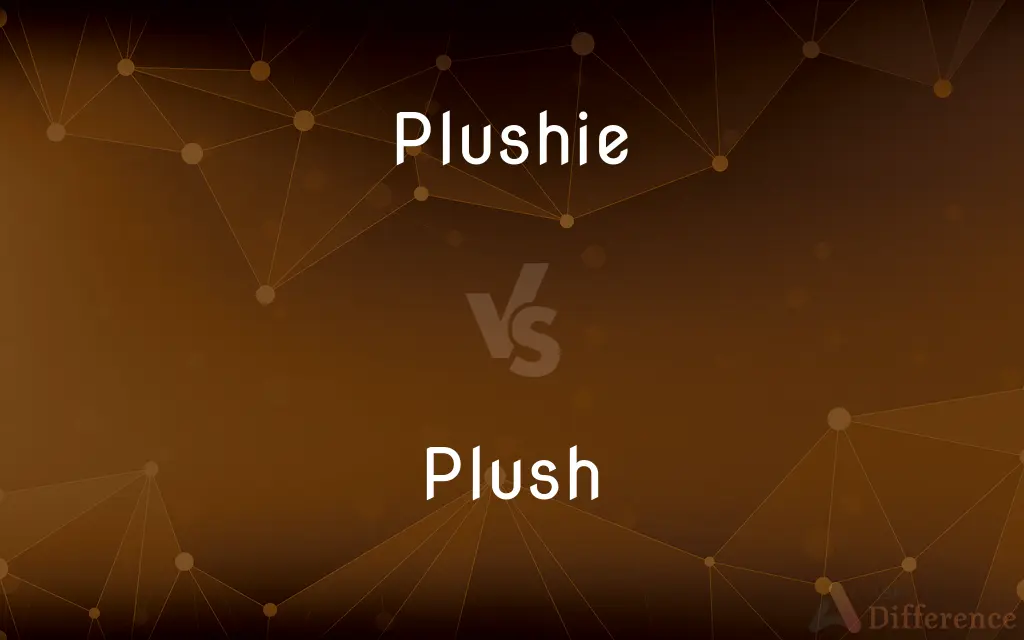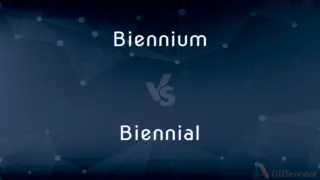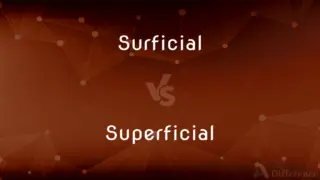Plushie vs. Plush — What's the Difference?
By Tayyaba Rehman & Maham Liaqat — Updated on April 23, 2024
Plush refers to a fabric with a deep, luxurious pile, often used in furniture and clothing, while plushies are soft toys made from plush fabric.

Difference Between Plushie and Plush
Table of Contents
ADVERTISEMENT
Key Differences
Plush is a fabric characterized by its soft, dense pile, commonly used in the production of textiles like upholstery and clothing. Whereas plushies are stuffed toys crafted from plush or other soft materials, designed for comfort and collectibility.
Plush offers a luxurious texture that is ideal for comfort and aesthetic appeal in home decor and garments. On the other hand, plushies serve as comforting companions, often beloved by children and collectors for their cuddly nature and adorable designs.
The production of plush involves weaving with a higher fiber density to achieve its signature softness. Meanwhile, plushies are manufactured by stuffing plush fabric with materials like polyester fiberfill, shaping them into various forms ranging from animals to fantasy characters.
Plush can be found in various grades that determine its softness and durability, making it versatile for different applications. In contrast, plushies are evaluated more on their craftsmanship and the safety of the materials used, ensuring they are suitable for all ages.
Maintaining plush fabric requires careful cleaning to preserve its soft pile, typically through dry cleaning or specialized washing methods. Plushies, however, often come with instructions for regular washing due to their frequent use in play, ensuring they remain hygienic and intact.
ADVERTISEMENT
Comparison Chart
Definition
Stuffed toys made from plush
A fabric with a soft, dense pile
Primary Use
Toys, collectibles
Textiles for upholstery, clothing
Texture
Soft, varies by filling material
Soft, luxurious
Maintenance
Frequently washable
Often requires dry cleaning
Target Audience
Children, collectors
Adults in home decor, fashion
Compare with Definitions
Plushie
Soft Toy.
He won a giant plushie at the carnival game.
Plush
Luxury Material.
Her winter coat is lined with plush for extra warmth.
Plushie
Stuffed Toy.
Her bed is covered with an assortment of colorful plushies.
Plush
Soft Fabric.
The new couch is covered in a plush that feels luxurious to touch.
Plushie
Crafted with Plush Fabric.
Plushies often mimic real animals with lifelike softness.
Plush
Used in Upholstery.
They chose a dark blue plush for the restaurant booths.
Plushie
Children’s Comfort Object.
The child hugged her plushie to feel better.
Plush
Textile Variety.
Plush is popular in both fashion and home interiors for its aesthetic appeal.
Plushie
Collectible Item.
She collects plushies from different countries she visits.
Plush
Dense Pile Fabric.
Plush curtains are excellent for blocking out cold drafts.
Plush
Plush (from French peluche) is a textile having a cut nap or pile the same as fustian or velvet. Its softness of feel gave rise to the adjective "plush" to describe something soft or luxurious, which was extended to describe luxury accommodation, or something rich and full.Originally the pile of plush consisted of mohair or worsted yarn, but now silk by itself or with a cotton backing is used for plush, the distinction from velvet being found in the longer and less dense pile of plush.
Plush
A rich fabric of silk, cotton, wool, or a combination of these, with a long, soft nap
Plush upholstery
Plush
Richly luxurious and expensive
A plush Mayfair flat
Plush
A fabric of silk, rayon, cotton, or other material, having a thick deep pile.
Plush
Made of or covered with plush.
Plush
Luxurious.
Plush
(UK) Very extravagant.
Plush
(UK) Very expensive, or appearing expensive; opulent, luxurious.
They lived in a plush apartment complex.
Plush
Having a soft, fluffy exterior.
This plush toy is so cute and soft - I want it!
Plush
A textile fabric with a nap or shag on one side, longer and softer than the nap of velvet.
Plush
A plush toy.
Plush
A textile fabric with a nap or shag on one side, longer and softer than the nap of velvet.
Plush
A fabric with a nap that is longer and softer than velvet
Plush
Characterized by extravagance and profusion;
A lavish buffet
A lucullan feast
Common Curiosities
Can plush fabric be used for clothing?
Yes, plush is often used in clothing, particularly for jackets and linings due to its soft texture.
How are plushies typically filled?
Plushies are typically filled with materials like polyester fiberfill or foam beads.
Is there a difference in the cleaning requirements between plush and plushies?
Yes, plush may require dry cleaning while plushies often have washable options due to their frequent use.
Can plush vary in texture?
Yes, the texture of plush can vary based on the fiber density and the materials used.
Do plushies come in different sizes?
Yes, plushies come in a range of sizes, from small keychains to life-sized figures.
What materials are used to make plush?
Plush is made using soft, dense fibers like polyester or wool.
What are common uses for plush in home decor?
Plush is commonly used for items like throw pillows, blankets, and upholstery due to its soft texture.
Are plushies suitable for all age groups?
Yes, plushies are generally designed to be safe and suitable for all ages, including infants.
Why are plushies popular among collectors?
Collectors value plushies for their aesthetic appeal, variety, and the nostalgia associated with them.
Are plush fabrics expensive?
The cost of plush fabrics can vary widely depending on the quality and the fibers used.
How long do plushies last?
With proper care, plushies can last many years, even becoming lifelong keepsakes.
Share Your Discovery

Previous Comparison
Biennium vs. Biennial
Next Comparison
Surficial vs. SuperficialAuthor Spotlight
Written by
Tayyaba RehmanTayyaba Rehman is a distinguished writer, currently serving as a primary contributor to askdifference.com. As a researcher in semantics and etymology, Tayyaba's passion for the complexity of languages and their distinctions has found a perfect home on the platform. Tayyaba delves into the intricacies of language, distinguishing between commonly confused words and phrases, thereby providing clarity for readers worldwide.
Co-written by
Maham Liaqat













































